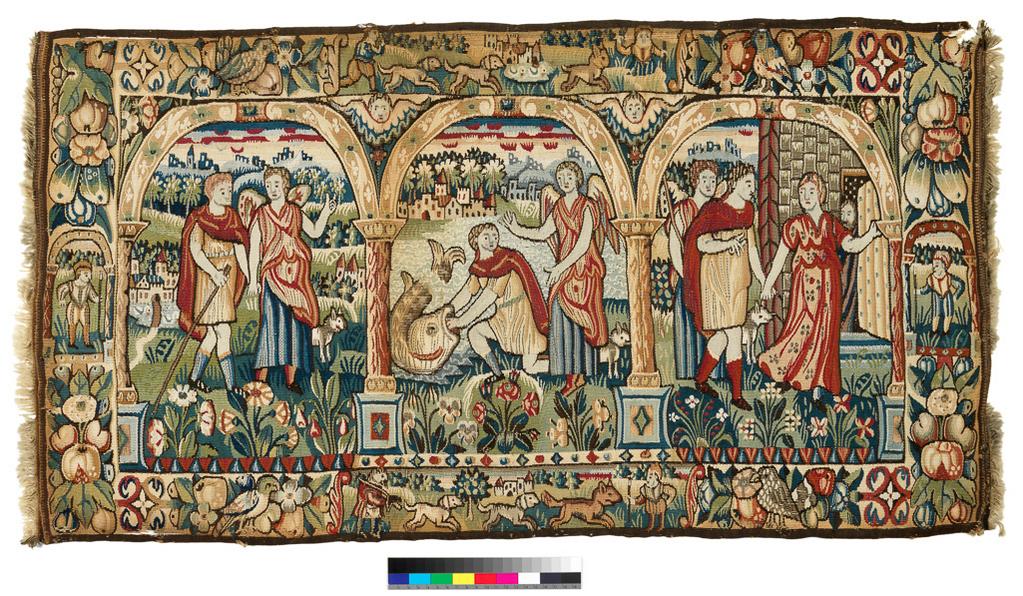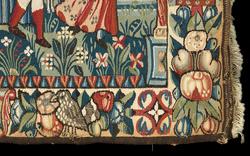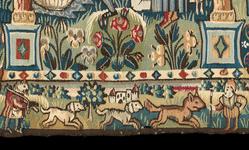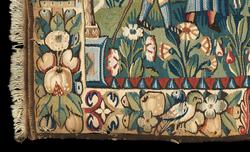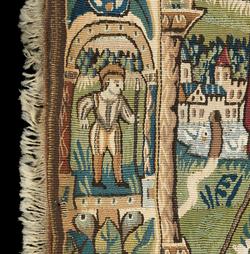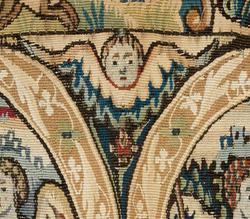Awaiting location update
Titles
Tobias and the Angel
Maker(s)
Unknown
Entities
Categories
Description
Cushion cover, woven tapestry in 'Sheldon' style, depicting three scenes from the biblical story of Tobias and the Angel.
This tapestry shows three scenes from the Old Testament story of Tobias and the Angel. Each is framed by an arch and separated by a cherub; different flowers decorate the corners.
The tapestry scenes do not follow the order of the Bible story. In the first, Tobias, son of Tobit and Anna, sets out on a journey with his dog and an angelic companion, Raphael. They were to collect a debt owed by Tobit’s cousin. On the way, shown in the second scene, the Angel makes Tobias catch a large fish and keep its guts for medicinal purposes.
The story, but not the tapestry, continues with the adventures of Tobias with his cousin’s family; he was made so welcome that a marriage was arranged with his cousin’s daughter. She had already been married seven times, and on each occasion a demon caused the groom to die on his wedding night. Tobias, however, burned part of the fish guts and conquered the demon.
Married, he now returns home, the last scene on the tapestry. Tobias is welcomed home by his mother. His father, still blind, sits inside. There would probably have been another square cushion showing the end of the story, depicting Tobias using the last bits of the fish to cure his father’s blindness.
The borders show fruit, flowers, birds and hunters. Diagonally opposite each other top and bottom are thrushes with speckled breasts perched amongst leaves. Towards the corners a clover-leaf motif leads the eye into the two different arrangements of fruit and flowers that decorate the side borders, separated by the figure of an armed man. Although the drawing is the same, their clothing is differently coloured.
The weaver showed different hunting scenes in the top and bottom borders. In the background of the upper border, ducks swim in the moat of a large house; in the lower border, huntsmen chase a fox.
Biblical references: Book of Tobit, scene 1 – 5:16; scene 2 – 6:2-4; scene 3 – 11:9
Notes
History note: Bought from R. Ellis Lyons
Legal notes
Bought using the Grace Clarke Fund
Measurements and weight
Height: 52.7 cm
Width: 101 cm
Acquisition and important dates
Method of acquisition: Bought
(1953-07-21)
by
Lyons, R. Ellis
Dating
16th Century, Late
1575
-
1599
Note
There is no maker’s mark on this panel. They were not thought necessary for small items. We can only guess therefore where this tapestry was made by comparing its style and appearance with other small works. The heartlands of the tapestry industry in the 1500s was in modern-day Belgium, in the towns of Brussels, Oudenarde, Enghien and later, Antwerp. The inhabitants tended towards the new Protestant religion but because the area was ruled by the Catholic king of Spain there was constant warfare. This, together with the fact that there were too many weavers for all of them to find employment against a disrupted commercial background, meant that many emigrated – north to Holland and west and north into the German principalities and beyond.
Others came to England, especially after 1560 following the accession of the Protestant Queen, Elizabeth I. The majority settled in London; others were invited by the town councils of Sandwich, Canterbury, Maidstone, Colchester and Norwich in the hope that new industries would revive the flagging local economies.
The settlement of émigrés was encouraged by the English government, aware that England lacked skilled craftsmen in the luxury trades. Some noblemen tried to set up workshops for foreign workers, usually with the obligation that they should pass on their skills to the native-born. One such man was Worcestershire nobleman, William Sheldon, who set out a scheme in his Will that would provide capital sums as loans for trained weavers, English or foreign-born, to enable them to set up independently. He also allowed a man we know as Richard Hyckes to occupy the family’s manor house at Barcheston, Warwickshire, rent-free, as long as he organised the production of tapestry and woven cloth.
How successful his plans were is unknown. Nothing is documented; there is no contract for any of the weavings now called Sheldon, nor do the workshop’s accounts survive. It was not until 1919 that a local antiquary claimed five tapestries, previously ignored, at nearby Chastleton House, as Barcheston work. Thereafter almost any tapestry without known origin or any tapestry with an English coat of arms became known as ‘Sheldon’ work, from Barcheston. But there was no solid explanation why this should be so.
Although the Fitzwilliam tapestries have been thought to be examples from Barcheston, there is no factual justification for this opinion. All the researchers of the 1920s – until recently the only studies of ‘Sheldon’ products – ignored the presence of émigré weavers in London. Barcheston was not the only place in England where tapestry was woven, as was previously thought. There is a strong possibility that the Fitzwilliam tapestries were woven in London where the émigré weavers established their workshops, and where there was a market.
This is almost certainly a cushion cover and would have been part of a set of six, or even twelve, each portraying a different episode in the story. At least 22 differently coloured wools were used to weave this tapestry. Previously described as 'Sheldon' work, made in Barcheston, it is now thought that this cover was probably woven in London.
Warp count: 7/8 per cm, 16/17 per inch
Materials used in production
Gold thread
Wool
Silk
Techniques used in production
Tapestry (process)
Identification numbers
Accession number: T.1-1953
Primary reference Number: 77888
Stable URI
Audit data
Created: Saturday 6 August 2011
Updated: Monday 24 November 2025
Last processed: Monday 24 November 2025
Associated departments & institutions
Owner or interested party:
The Fitzwilliam Museum
Associated department:
Applied Arts
